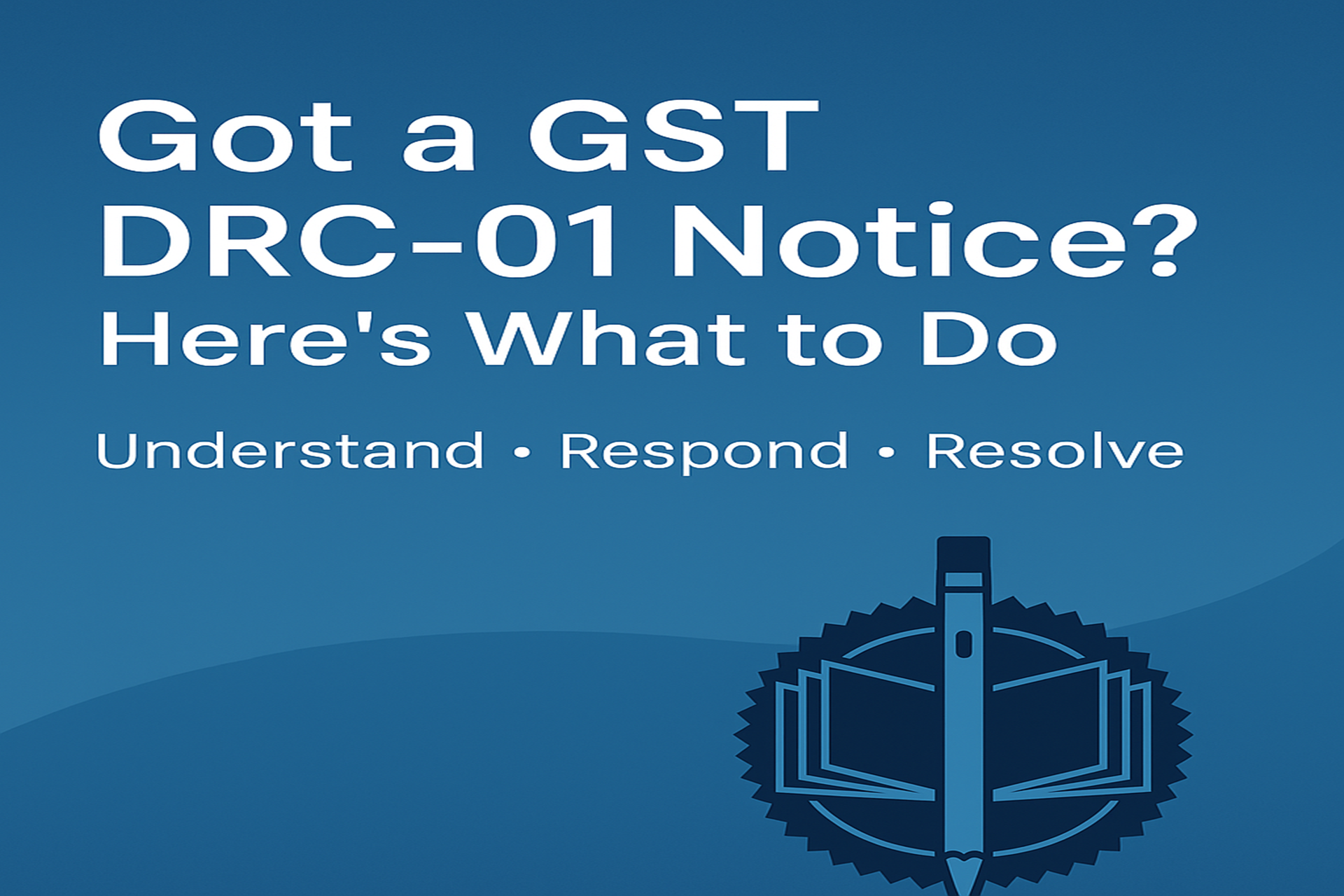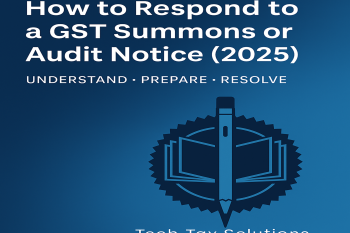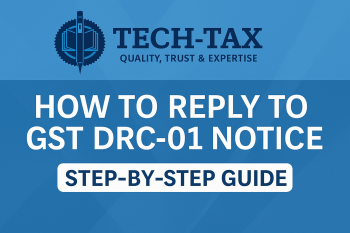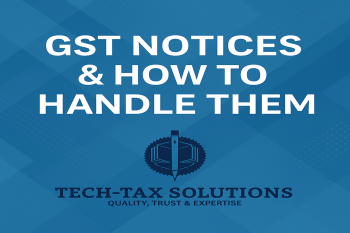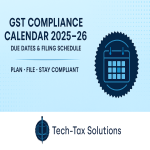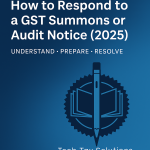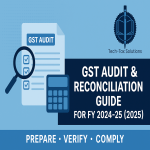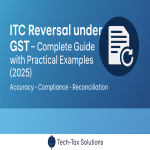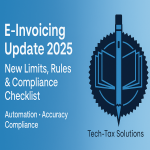🔹 Introduction
Receiving a DRC-01 notice under GST can be stressful for any business owner. However, it’s important to understand that a DRC-01 is not a penalty order, but a show-cause notice — giving you an opportunity to explain discrepancies or errors before any tax demand is finalized.
The GST law empowers the department to issue such notices when discrepancies are found in returns, ITC claims, mismatched invoices, or tax payments.
This article breaks down what a DRC-01 notice means, common reasons for its issue, and step-by-step actions you should take to handle it effectively under the GST framework as of 2025.
🔹 Legal Framework
The DRC-01 notice is governed by the following provisions:
-
Section 73 of the CGST Act, 2017 – Tax not paid or short paid, or ITC wrongly availed without fraud or willful misstatement.
-
Section 74 of the CGST Act, 2017 – Tax short paid or ITC wrongly availed due to fraud, suppression, or misstatement.
-
Rule 142 of the CGST Rules, 2017 – Communication of demand, notices, and orders through Form DRC-01 and DRC-02.
-
Form DRC-01 – Issued electronically on the GST portal as a summary of show cause notice (SCN).
📘 Purpose:
To inform taxpayers of discrepancies and provide an opportunity to respond before a formal demand is raised via Form DRC-07.
🔹 Understanding GST DRC-01 Notice
A Form DRC-01 is an electronic summary of a Show Cause Notice (SCN) issued under Section 73 or 74 of the CGST Act.
It usually states:
-
The reason for notice (e.g., short payment, ineligible ITC, etc.).
-
The amount of tax, interest, and penalty proposed.
-
The period involved (e.g., FY 2022–23).
-
A deadline to reply and/or pay.
💡 Important:
You can reply online through Form DRC-06 within the prescribed time to avoid further escalation.
🔹 Common Reasons for Receiving DRC-01
| Reason | Description |
|---|---|
| ITC mismatch | Claimed ITC not reflected in GSTR-2B or supplier’s GSTR-1. |
| Tax short payment | Difference between GSTR-1 (sales) and GSTR-3B (tax paid). |
| Non-filing of returns | Failure to file returns leading to estimated tax liability. |
| Excess refund claim | Ineligible refund or export turnover discrepancies. |
| E-way bill mismatch | Goods movement without matching invoices. |
| Audit observation | Discrepancies noticed during departmental audit. |
🔹 Step-by-Step Guide: What to Do After Receiving DRC-01
✅ Step 1: Download and Review the Notice
Login to the GST Portal → Services → User Services → View Additional Notices and Orders.
Download Form DRC-01 and review:
-
Tax period involved
-
Section under which issued (73 or 74)
-
Computation details and evidence
✅ Step 2: Identify the Root Cause
Reconcile relevant data such as:
-
GSTR-1 vs GSTR-3B
-
ITC claimed vs GSTR-2B
-
E-way bill vs outward supplies
This helps confirm whether the department’s claim is valid or needs clarification.
✅ Step 3: File Reply in Form DRC-06
You must reply within the stipulated time (generally 30 days).
Prepare a detailed explanation, supported by documents like invoices, ledgers, and reconciliation statements.
📌 Navigate:
GST Portal → Services → User Services → Additional Notices → Reply → Form DRC-06.
✅ Step 4: Optional Payment Before Adjudication
If you agree with the discrepancy, you can pay before the final order to avoid penalty:
-
Under Section 73 – Pay tax + interest → case closed.
-
Under Section 74 – Pay tax + interest + 15% penalty → case closed.
Payment can be made using Form DRC-03 (Voluntary Payment).
✅ Step 5: Attend Hearing (if applicable)
If the officer schedules a hearing, attend and provide supporting explanations or clarifications.
✅ Step 6: Wait for Adjudication Order (if unresolved)
After considering your reply, the officer will issue an order in Form DRC-07 with the final payable amount.
You can appeal further if you disagree with the order.
🔹 Example Scenario
Example:
ABC Traders received a DRC-01 notice for FY 2023–24 stating ₹2,40,000 ITC wrongly claimed due to supplier non-filing.
After reconciliation, ABC found the supplier filed GSTR-1 late. They submitted proof via DRC-06 and the case was closed without penalty.
🔹 Common Mistakes to Avoid
-
❌ Ignoring the notice or missing reply deadlines.
-
❌ Submitting reply without reconciliation backup.
-
❌ Making payments without checking section (73 vs 74).
-
❌ Assuming DRC-01 is a final order — it’s a show cause, not a demand.
-
❌ Not downloading the SCN PDF, which contains detailed reasoning.
🔹 Best Practices
✅ Regularly reconcile GSTR-1, 3B, and 2B to prevent mismatches.
✅ Maintain communication records with suppliers for ITC linkage.
✅ Keep a dedicated GST compliance folder with invoices and ledgers.
✅ Respond to notices promptly and professionally.
✅ Seek professional help for DRC-01 replies involving large amounts.
🔹 FAQs
Q1. What is DRC-01 under GST?
➡️ It’s a summary of a show cause notice issued for tax short payment or incorrect ITC under Section 73/74 of the CGST Act.
Q2. Is DRC-01 a final demand?
➡️ No. It’s a preliminary notice before adjudication. You can reply or pay voluntarily.
Q3. What is the time limit to reply to DRC-01?
➡️ Generally 30 days from the date of service, extendable at officer’s discretion.
Q4. Can I pay and close the DRC-01 case voluntarily?
➡️ Yes, using Form DRC-03 before adjudication to avoid penalties.
Q5. Can Tech-Tax Solutions help in drafting a DRC-06 reply?
➡️ Absolutely. Our GST experts assist in drafting precise replies, reconciliation, and representation before authorities.
🔹 Conclusion
A DRC-01 notice is not a cause for panic but a call for clarification.
Timely review, accurate reconciliation, and a well-prepared reply can resolve most cases without penalties or litigation.
📌 Need expert assistance in DRC-01 response drafting, reconciliation, or voluntary payment filing (DRC-03)?
Contact Tech-Tax Solutions – Quality, Trust & Expertise in Ghaziabad, Noida & Delhi for professional GST support.
